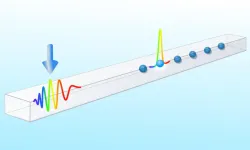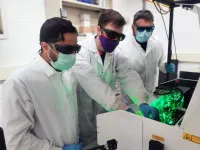Progress in fused-ring electron acceptors made by PKU Zhan Xiaowei's group
2021-03-12
(Press-News.org) During 1995-2015, fullerene derivatives had been the dominating electron acceptors in organic solar cells (OSCs) owing to their performance superior to other acceptors. However, the drawbacks of fullerenes, such as weak visible absorption, limited tunability of electronic properties and morphological instability, restrict further development of OSCs toward higher efficiencies and practical applications. Therefore, the development of new acceptors beyond fullerenes is urgent in the field of OSCs.
Professor Zhan Xiaowei from the College of Engineering at Peking University is one of the pioneers engaging in development of nonfullerene acceptors in the world. In 2007, Zhan's group pioneered perylene diimide-based polymer acceptors (J. Am. Chem. Soc., 2007, 129, 7246, cited 1067 times). In 2015, they invented the star molecule ITIC (Adv. Mater., 2015, 27, 1170, cited 1921 times) and proposed the concept of fused-ring electron acceptor (FREA). Then, they developed a variety of molecular design strategies, modulated the molecular properties through engineering on fused-ring cores, π-bridges, end groups and side chains, and revealed the structure-property relationships. They found new device physics and photophysics in FREAs, different from fullerenes. They fabricated high-performance OSCs and FREA-perovskite hybrid cells. The chemical features, physical features and device features of FREAs are different from traditional fullerenes. Thanks to the invention of FREA, OSCs have achieved unprecedented breakthroughs with efficiencies surpassing 18% in 5 years. FREA brings a revolution for OSC field and heralds the arrival of nonfullerene era.
FREAs have also been used in other fields, such as perovskite solar cells, quantum dot solar cells, solar water splitting, photodetectors, field-effect transistors, two-photon absorption, photothermal therapy, etc. FREAs have attracted broad attention around the world: over 150 groups are using FERAs in OSCs, over 50 groups are using FREAs in other fields, and over 10 companies are selling FREAs. Nowadays, FREA is a new and hot field led by Chinese scientists and followed worldwide.
Zhan's group has published over 150 papers with over 15000 citations in the field of FREA, among which 36 are selected as ESI highly cited papers, 20 as ESI hot papers, and 7 as the 100 most influential international papers in China. Recently, Zhan's group published an invited review entitled Fused-Ring Electron Acceptors for Photovoltaics and Beyond in Accounts of Chemical Research (Acc. Chem. Res., DOI: 10.1021/acs.accounts.0c00575). In this review, molecular design, device engineering, photophysics and applications of FREAs are discussed in detail, and the challenges and future research directions are also proposed.
INFORMATION:
The research works were supported by the National Nature Science Foundation of China and Basic Research Promotion Project of Peking University.
[Attachments] See images for this press release:

ELSE PRESS RELEASES FROM THIS DATE:
2021-03-12
University of Otago researchers have discovered one of the reasons why more than 50 per cent of people with type 2 diabetes die from heart disease.
And perhaps more significantly, they have found how to treat it.
Associate Professor Rajesh Katare, of the Department of Physiology, says it has been known that stem cells in the heart of diabetic patients are impaired. While stem cell therapy has proved effective in treating heart disease, it is not the case in diabetic hearts.
It has not been known why; until now.
It comes down to tiny molecules called microRNA which control gene expression.
"Based on the results of laboratory testing, ...
2021-03-12
New bioarchaeological research shows malaria has threatened human communities for more than 7000 years, earlier than when the onset of farming was thought to have sparked its devastating arrival.
Lead author Dr Melandri Vlok from the Department of Anatomy, University of Otago, says this ground-breaking research, published today in Scientific Reports, changes the entire understanding of the relationship humans have had with malaria, still one of the deadliest diseases in the world.
"Until now we've believed malaria became a global threat to humans when we turned to farming, but our research shows in at least Southeast Asia this disease was a threat to human groups well before that.
"This research providing a new cornerstone of malaria's evolution with humans is a great achievement ...
2021-03-12
When people think of sea level rise, they usually think of coastal erosion. However, recent computer modeling studies indicate that coastal wastewater infrastructure, which includes sewer lines and cesspools, is likely to flood with groundwater as sea-level rises.
A new study, published by University of Hawai'i (UH) at Mānoa earth scientists, is the first to provide direct evidence that tidally-driven groundwater inundation of wastewater infrastructure is occurring today in urban Honolulu, Hawai'i. The study shows that higher ocean water levels ...
2021-03-12
Light-emitting diodes (LEDs) have revolutionized the displays industry. LEDs use electric current to produce visible light without the excess heat found in traditional light bulbs, a glow called electroluminescence. This breakthrough led to the eye-popping, high-definition viewing experience we've come to expect from our screens. Now, a group of physicists and chemists have developed a new type of LED that utilizes spintronics without needing a magnetic field, magnetic materials or cryogenic temperatures; a "quantum leap" that could take displays to the next level.
"The companies that make LEDs or TV and computer displays don't want to deal with magnetic fields and magnetic materials. It's heavy ...
2021-03-12
TOKYO - Toshiba Corporation (TOKYO: 6502), the industry leader in solutions for large-scale optimization problems, today announced a scale-out technology that minimizes hardware limitations, an evolution of its optimization computer, the Simulation Bifurcation Machine (SBM), that supports continued increases in computing speed and scale. Toshiba expects the new SBM to be a game changer for real-world problems that require large-scale, high-speed and low-latency, such as simultaneous financial transactions involving large numbers of stock, and complex control of multiple robots. The research results were published in Nature Electronics*1 on March 1.
Speed and scale are keys to success in industrial sectors ...
2021-03-12
Waste cooking oil, sulfur and wool offcuts have been put to good use by green chemists at Flinders University to produce a sustainable new kind of housing insulation material.
The latest environmentally friendly building product from experts at the Flinders Chalker Lab and colleagues at Deakin and Liverpool University, has been described in a new paper published in Chemistry Europe ahead of Global Recycling Day (18 March 2021)
The insulating composite was made from the sustainable building blocks of wool fires, sulfur, and canola oil to produce a promising new model for next-generation insulation - not only capitalising on wool's natural low flammability but also to make significant energy savings for property owners and tenants.
The new composite is one of several exciting ...
2021-03-12
Magnetic reconnection refers to the reconfiguration of magnetic field geometry. It plays an elemental role in the rapid release of magnetic energy and its conversion to other forms of energy in magnetized plasma systems throughout the universe.
Researchers led by Dr. LI Leping from the National Astronomical Observatories of the Chinese Academy of Sciences (NAOC) analyzed the evolution of magnetic reconnection and its nearby filament. The result suggested that reconnection is significantly accelerated by the propagating disturbance caused by the adjacent filament eruption.
The study was published in The Astrophysical Journal on Feb. 25.
The New Vacuum Solar Telescope (NVST) is a ...
2021-03-12
In order to exploit the properties of quantum physics technologically, quantum objects and their interaction must be precisely controlled. In many cases, this is done using light. Researchers at the University of Innsbruck and the Institute of Quantum Optics and Quantum Information (IQOQI) of the Austrian Academy of Sciences have now developed a method to individually address quantum emitters using tailored light pulses. "Not only is it important to individually control and read the state of the emitters," says Oriol Romero-Isart, "but also to do so while leaving the system as undisturbed as possible." Together with Juan Jose? Garci?a-Ripoll (IQOQI visiting fellow) from the Instituto de Fi?sica Fundamental in Madrid, Romero-Isart's research group has ...
2021-03-12
CLEMSON, South Carolina -- By using laser spectroscopy in a photophysics experiment, Clemson University researchers have broken new ground that could result in faster and cheaper energy to power electronics.
This novel approach, using solution-processed perovskite, is intended to revolutionize a variety of everyday objects such as solar cells, LEDs, photodetectors for smart phones and computer chips. Solution-processed perovskite are the next generation materials for solar cell panels on rooftops, X-ray detectors for medical diagnosis, and LEDs for daily-life lighting.
The research team included ...
2021-03-12
A multiyear workplace health promotion program can slow down the increase in health risks for working-age people. A study by the Faculty of Sport and Health Sciences at the University of Jyväskylä followed what kind of changes happened among participants during an eight-year workplace health promotion program in smoking, minor exercise, high blood pressure, musculoskeletal disorders, and overweight. The results of the study were encouraging for health promotion.
According to earlier studies, a high number of health risks are connected to an increase in occupational health care costs, lower productivity at work, and the growing number of sickness ...
LAST 30 PRESS RELEASES:
[Press-News.org] Progress in fused-ring electron acceptors made by PKU Zhan Xiaowei's group








